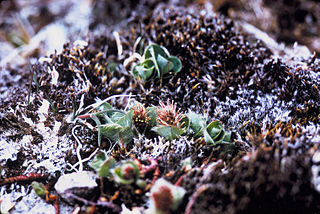
Salix discolor, the American pussy willow or glaucous willow, is a species of willow native to North America, one of two species commonly called pussy willow.

Salix pentandra, the bay willow, is a species of willow native to northern Europe and northern Asia. The scientific name refers to the male flowers having five stamens. The English name derives from the resemblance of the leaves to those of the bay laurel; other common names include bay-leaved willow and laurel willow. Its glossy leaves make it more decorative than many other willows, so it is often planted as an ornamental tree.

Salix arctica, the Arctic willow, is a tiny creeping willow. It is adapted to survive in Arctic conditions, specifically tundras.

Salix lucida, the shining willow, Pacific willow, red willow, or whiplash willow, is a species of willow native to northern and western North America, occurring in wetland habitats. It is the largest willow found in British Columbia.

Salix scouleriana is a species of willow native to northwestern North America. Other names occasionally used include fire willow, Nuttall willow, mountain willow, and black willow.

Salix exigua is a species of willow native to most of North America except for the southeast and far north, occurring from Alaska east to New Brunswick, and south to northern Mexico. It is considered a threatened species in Massachusetts while in Connecticut, Maryland, and New Hampshire it is considered endangered.

Salix barrattiana is a species of flowering plant in the willow family known by the common name Barratt's willow. It is native to North America, where it is distributed across Alaska and western Canada, with also a few populations in Montana and Wyoming. These disjunct populations are probably relics from a time when the climate was colder. The southernmost population is technically in Wyoming, but it is located at the Montana state line and it is limited to one clone of all-staminate plants within an area of 100 square meters (1,100 sq ft) in a high-elevation habitat.

Salix bebbiana is a species of willow indigenous to Canada and the northern United States, from Alaska and Yukon south to California and Arizona and northeast to Newfoundland and New England. Common names include beaked willow, long-beaked willow, gray willow, and Bebb's willow. This species is also called red willow by Native Americans according to The Arctic Prairies Appendix E by Ernest Tompson Seton.

Salix geyeriana is a species of willow known by the common names Geyer's willow, Geyer willow and silver willow. The type specimen was collected by the botanist Karl Andreas Geyer, for whom it was named. Its conspicuous, yellow flowers begin to bloom as early as March, to as late as the end of June.

Carex bigelowii is a species of sedge known by the common names Bigelow's sedge, Gwanmo sedge, and stiff sedge. It has an Arctic–alpine distribution in Eurasia and North America, and grows up to 50 centimetres (20 in) tall in a variety of habitats.

Salix alaxensis is a species of flowering plant in the willow family known by the common names Alaska willow and feltleaf willow. It is native to northern North America, where it occurs throughout Alaska and northwestern Canada.

Salix arbusculoides is a species of flowering plant in the willow family known by the common name little tree willow. It is native to northern North America, where its distribution extends across Alaska and most of Canada.

Salix brachycarpa is a species of flowering plant in the willow family known by the common names barren-ground willow, small-fruit willow and shortfruit willow.

Salix glauca is a species of flowering plant in the willow family known by the common names gray willow, grayleaf willow, white willow, and glaucous willow. It is native to North America, where it occurs throughout much of Alaska, northern and western Canada, and the contiguous United States south through the Rocky Mountains to northern New Mexico. It can also be found in Greenland, northwestern Europe, and Siberia.

Salix hastata is a species of flowering plant in the willow family, known by the common name halberd willow. It has an almost circumpolar distribution, occurring throughout the northern latitudes of the Northern Hemisphere, most frequently found near the coast of the Arctic Ocean. In Alaska, it occurs in the north and in the central mountains. It also occurs in northwestern Canada, and in Norway and Russia, as well as various alpine or mountainous areas of Eurasia.

Salix monticola is a species of flowering plant in the willow family known by the common names mountain willow, cherry willow, serviceberry willow, and park willow. It is native to the United States, where it occurs in the Rocky Mountains region from Wyoming to Arizona and New Mexico. It also occurs in Alaska and parts of Canada.

Salix myrtillifolia is a species of flowering plant in the willow family known by the common name blueberry willow. It is native to northern North America, where it occurs in Alaska and much of Canada.

Salix pulchra is a species of flowering plant in the willow family, known by the common names diamondleaf willow, tealeaf willow, and thin red willow. It is native to northern North America, where it occurs in Alaska, Yukon, the Northwest Territories, and Nunavut. The species is also found in northern British Columbia, and occurs in Russia.

Salix richardsonii is a species of flowering plant in the Salicaceae, or willow family. It is known by the common names Richardson's willow and woolly willow. It is native to Russia and northern North America, where it occurs in Alaska and northern Canada. Some authorities consider it to be a subspecies, Salix lanata subsp. richardsonii(Hook.) A. K. Skvortsov rather than a species itself.

Salix serissima is a species of flowering plant in the willow family known by the common names autumn willow and fall willow. It is native to North America, where it is distributed across much of Canada and the northern contiguous United States.





















